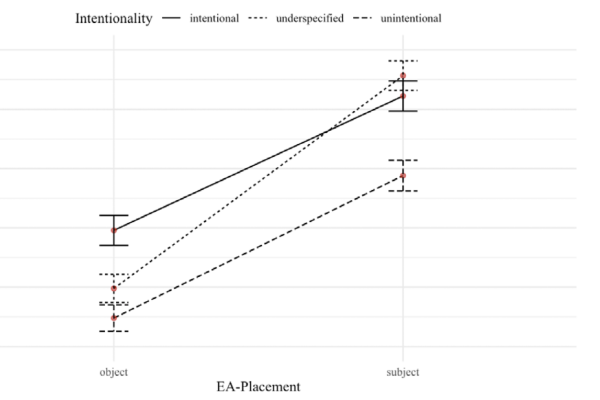18.10.2024

Kalle Glauch stellt in Language and Cognition eine neue experimentelle Studie zur “Culprit-Hypothesis” in zur Interpretation von expressiven Adjektiven vor.
Kalle Glauch. 2024. The culprit-hypothesis: how blame attribution influences the interpretation of expressive adjectives. Language and Cognition. doi: 10.1017/langcog.2024.56
Abstract: Frazier and colleagues, in 2015, proposed the speech-act hypothesis as an inferentially rich pragmatic account for the interpretational flexibility of expressive adjectives (EAs) (e.g., damn, frigging). One pragmatic cue in EA interpretation proposed by Frazier and colleagues is the Culprit-Hypothesis, which predicts that the likelihood of EAs targeting the subject-referent of an utterance increases with the degree of its perceived culpability or blameworthiness in negative events. This article aims to refine the Culprit-Hypothesis by embedding it in a robust theoretical framework based on the psychological models of blame attribution and providing reliable empirical validation. Focusing on the role of intentionality, one of the major components of blame attribution, this article reports a forced-choice study investigating the influence of blameworthiness on EA interpretation. The study followed a 2x3 within-subject repeated measures design, with sentences manipulated by the factors intentionality (intentional versus unintentional versus underspecified) and EA placement (subject-internal versus object-internal) (The [damn] NOUN1 [intentionally  unintentionally
unintentionally  ϕ] verbs the [damn] NOUN2). Participants (n = 100) read the sentences and selected their preferred interpretation of the EA among the subject-referent, the object-referent and the event-referent. A generalized linear mixed effects model fitted to the data reveals that intentional actions are significantly more likely to result in subject-readings compared to unintentional actions, thus corroborating the Culprit-Hypothesis.
ϕ] verbs the [damn] NOUN2). Participants (n = 100) read the sentences and selected their preferred interpretation of the EA among the subject-referent, the object-referent and the event-referent. A generalized linear mixed effects model fitted to the data reveals that intentional actions are significantly more likely to result in subject-readings compared to unintentional actions, thus corroborating the Culprit-Hypothesis.
Kalle Glauch stellt in Language and Cognition eine neue experimentelle Studie zur “Culprit-Hypothesis” in zur Interpretation von expressiven Adjektiven vor.
Kalle Glauch. 2024. The culprit-hypothesis: how blame attribution influences the interpretation of expressive adjectives. Language and Cognition. doi: 10.1017/langcog.2024.56
Abstract: Frazier and colleagues, in 2015, proposed the speech-act hypothesis as an inferentially rich pragmatic account for the interpretational flexibility of expressive adjectives (EAs) (e.g., damn, frigging). One pragmatic cue in EA interpretation proposed by Frazier and colleagues is the Culprit-Hypothesis, which predicts that the likelihood of EAs targeting the subject-referent of an utterance increases with the degree of its perceived culpability or blameworthiness in negative events. This article aims to refine the Culprit-Hypothesis by embedding it in a robust theoretical framework based on the psychological models of blame attribution and providing reliable empirical validation. Focusing on the role of intentionality, one of the major components of blame attribution, this article reports a forced-choice study investigating the influence of blameworthiness on EA interpretation. The study followed a 2x3 within-subject repeated measures design, with sentences manipulated by the factors intentionality (intentional versus unintentional versus underspecified) and EA placement (subject-internal versus object-internal) (The [damn] NOUN1 [intentionally  unintentionally
unintentionally  ϕ] verbs the [damn] NOUN2). Participants (n = 100) read the sentences and selected their preferred interpretation of the EA among the subject-referent, the object-referent and the event-referent. A generalized linear mixed effects model fitted to the data reveals that intentional actions are significantly more likely to result in subject-readings compared to unintentional actions, thus corroborating the Culprit-Hypothesis.
ϕ] verbs the [damn] NOUN2). Participants (n = 100) read the sentences and selected their preferred interpretation of the EA among the subject-referent, the object-referent and the event-referent. A generalized linear mixed effects model fitted to the data reveals that intentional actions are significantly more likely to result in subject-readings compared to unintentional actions, thus corroborating the Culprit-Hypothesis.
Wenn wir uns ärgern, greifen wir oft zu besonders ausdrucksstarker Sprache: „Der verdammte Hund hat den Kuchen gefressen!“ Solche Ausdrücke transportieren Ärger und lassen uns spontan auf den vermeintlich Schuldigen zeigen. Kalle Glauch untersucht in seinem Artikel „The Culprit-Hypothesis: how blame attribution influences the interpretation of expressive adjectives“, wie solche Schuldzuweisungen das Verständnis von expressiven Adjektiven – etwa „verdammt“ – beeinflussen. Aufgrund der vorliegenden Daten lässt sich feststellen, dass diese Adjektive eine negative Haltung des Sprechers ausdrücken, wobei sie flexibel auf differente Referenten in einem Satz angewendet werden können. Angesichts der aktuellen Forschungsergebnisse ist eine Neubewertung notwendig, sodass die Culprit-Hypothese erweitert wird, die besagt, dass die Wahrscheinlichkeit, eines solchen Adjektivs auf das Subjekt eines Satzes zu beziehen, steigt, sofern dieses als schuldhaft wahrgenommen wird. Im Rahmen der Untersuchung, die Glauch durchführt, zeigt sich, dass intentional handelnde Subjekte signifikant häufiger mit negativen Adjektiven beschrieben werden als solche, die unabsichtlich handeln. Diese Erkenntnis untermauert die Culprit-Hypothese: Menschen tendieren demnach dazu, jene zu beschuldigen, die für negative Ereignisse verantwortlich gemacht werden können. Interessanterweise wird diese Tendenz durch die Platzierung des Adjektivs im Satz beeinflusst – wenn das Adjektiv direkt beim Subjekt steht, wird es eher auf das Subjekt bezogen. Ein zentrales Anliegen des Artikels besteht darin, dass die Zuschreibung von Schuld eine essenzielle Rolle in der Interpretation von expressiven Adjektiven spielt. Besonders spannend ist, dass Glauch dies durch psychologische Modelle der Schuldzuschreibung fundiert und eine breite empirische Grundlage für diese Theorie schafft. Somit werden neue Ansätze zur Analyse von Sprache und Emotionen eröffnet.